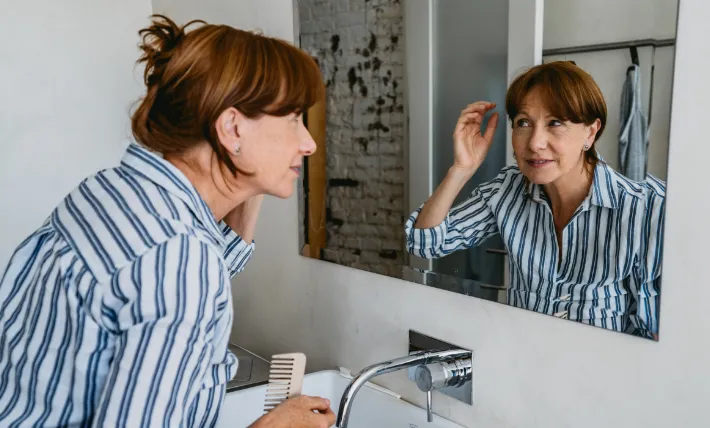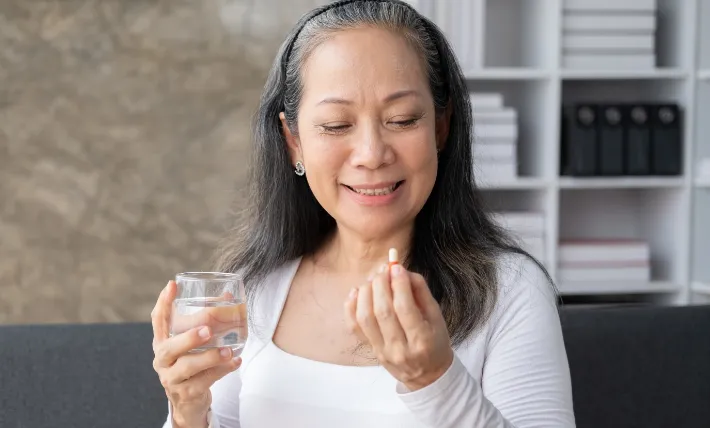When you think about hair loss, you might think it mostly affects men. But it’s common in women, too. About half of all women will have hair loss at some point in their lives. Most start to notice it in their 50s and 60s, but it can happen at any age and for a variety of reasons.
Most people lose anywhere from 50 to 100 strands of hair a day. If you lose a lot more than that, you may have noticeable hair loss. Symptoms include:
- More hair than normal left in your comb or brush
- Lots of hair left in your shower drain, or on your pillow, towels and clothes
- Your hair looks thinner
- Patches of your scalp are visible
Before we break down hair loss causes and the treatments, let’s take a look at how your hair grows.
The circle of life … for your hair
Hair grows in cycles — three phases to be exact.
About 90% of the hair on your head is in this active growth phase at any time — which can last two to eight years. Hair grows about 6 inches a year for most people.
This short transition phase usually lasts about two to four weeks. Hair follicles shrink and hair stops growing.
During this phase, which lasts two to four months, the hair rests. At the end of this phase, it falls out and the growth cycle begins again.
Female pattern hair loss
The main type of hair loss in women is the same as it is in men. It’s called androgenetic alopecia, or female (or male) pattern hair loss.
“Alopecia” means hair loss and “androgenetic” involves hormones called androgens. Without getting too deep in the weeds, androgens are essential for normal male sexual development, and have other important functions in both sexes, including the regulation of hair growth.
Female pattern hair loss is the most common cause of female hair loss worldwide. It affects about 30 million American women, and can be an inherited condition (from your mom or dad or both). Chances for female pattern hair loss increase with age, especially after menopause.
Female pattern hair loss is marked by gradual thinning on the top third to half of the scalp. Women may notice their part is becoming gradually wider or that their ponytail feels less full. But with female pattern hair loss, a woman’s hairline rarely recedes, and women rarely become bald.
Female pattern hair loss treatments
Common treatments for female pattern hair loss (which is permanent without treatment) include:
- Over-the-counter (OTC) medications for your scalp like minoxidil (Rogaine®)
- Prescription oral medication such as finasteride (Propecia®)
- The use of finasteride along with ketoconazole 2% shampoo
- Low-level LED laser light therapy to help regrow hair
- Platelet-rich plasma — a specimen of your blood is drawn, processed, and then injected into your scalp to stimulate hair growth.
- Hair transplant — a surgical procedure that moves active follicles from the back of the scalp to the areas where hair is thinning. (But there are drawbacks. It can cost thousands of dollars, it won’t work for everyone, is not covered by insurance, and requires recovery time. And it’s more effective in treating smaller, more defined areas of balding, not thinning across the scalp.)
Can female pattern hair loss be prevented?
While there’s no known way to prevent female pattern hair loss, there are ways to keep your hair healthy that may promote hair growth, including:
-
Eat extra protein, especially if you’re a vegetarian or vegan. You need 40 to 60 grams of protein a day. (The Mediterranean diet includes protein, fruits and vegetables that might help minimize hair loss.)
-
Take vitamins. Certain minerals and vitamins, including vitamins A, B, C, D, E, zinc and iron, help maintain healthy hair, skin and muscle tissue.
Always talk with your doctor before you start up new OTC medications, multivitamins or supplements. You want to make sure they’re right for your health situation, and won’t counteract the effectiveness of any other medications you’re on.
The good news on female pattern hair loss
Some women aren’t bothered by female pattern hair loss and accept it as part of the aging process. But if you’re noticing more-than-usual hair loss, and it’s understandably distressing to you, reach out to your doctor. Female pattern hair loss is a treatable condition, and your dermatologist can help slow or replace your hair loss.
Other hair loss causes
There are other reasons why women, men — and sometimes children — experience hair loss. Here are just four of them.
Alopecia areata happens when the immune system attacks hair follicles. “Alopecia” means hair loss and “areata” means patchy, and this condition often presents as patchy hair loss.
Treatments for alopecia areata are wide-ranging and vary by patient.
Traction alopecia can be brought on by hairstyles like tight ponytails and braids. Other styling habits that can lead to breakage and thinning hair include high heat from blow dryers or flat irons, and chemicals from bleach, perms or other products.
If you stop wearing your hair in the tight style that caused the traction alopecia, the condition is reversible. Your dermatologist can treat the hair loss with minoxidil (Rogaine®) and, if needed, topical steroids to bring down swelling on your scalp.
This type of hair loss is caused by medications that compromise a growing hair follicle. Some types of chemotherapy are examples. Hair regrowth generally begins within a few months after treatment ends.
Telogen effluvium hair loss affects people after they experience a severe stress or change to their body, such as a serious infection, high fever, a thyroid imbalance, or a diet too low in protein, vitamins and minerals. Symptoms include thinning hair, most commonly on the top of your head rather than the back or sides of your head.
This type of hair loss is most often temporary and usually resolves on its own once the cause of the stressor on your body is identified and dealt with. It can last a relatively short time (a few months) or longer. Common treatments include minoxidil (Rogaine®), multivitamins that contain iron, or biotin supplements. But talk with your doc first.






